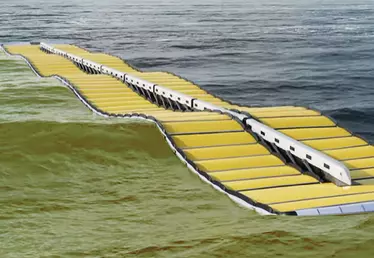

Hero banner custom title
Can the sea be a source of energy?
4 min
From waterwheels to hydroelectric power stations and the hydraulic turbine developed by Benoît Fourneyron in the 19th century, water has long been used as a source of energy. But what about the vast expanses of the sea? Can they also be used to produce electricity?
Taming tides
71% of planet Earth is covered in water, 96.5% of which is concentrated in the oceans. Under the combined action of gravitational forces and the Moon, these vast expanses are in constant motion (currents, tides, waves, etc.). Tidal energy is generated by these water movements. It is exploited in tidal power stations which use the difference in water height between high and low tide, called tidal range, to produce electricity. This is the case at La Rance in France, where the world's first tidal power plant was commissioned in 1966, and at Sihwa, in South Korea, which remains the largest to date with 254 MW of installed capacity. Although the generated electricity has the advantage of being renewable and predictable, the environmental impact of these installations is still not zero. Their operation requires the construction of dams in coastal areas with high tidal ranges and rich ecosystems. As Andrea Copping, an oceanographer at the Pacific Northwest National Laboratory points out:
“The natural ebb and flow of the ocean can provide an abundant and constant source of energy. But before placing electrical devices in the water, we need to know how they might impact the marine environment”
Hence the study of new, more respectful projects that rely on the creation of artificial lagoons, such as the Tidal power plant in the UK.
Under the sea
Another solution for generating electricity is to harness the kinetic energy of ocean or tidal currents. This is where tidal turbines come in. These underwater wind turbines are made up of blades that are set in motion by ocean currents. Their rotation drives an alternator which in turn produces an electric current of variable intensity. To increase efficiency, some players draw their inspiration from nature. The French start-up Eel Energy has created a membrane tidal turbine with an undulating movement that mimics that of eels. Other solutions also exist to exploit wave energy, the thermal energy of the sea or the osmotic energy from the difference in salinity between sea water and fresh water.
Seawater, deuterium and hydrogen
And that's not all. Seawater is also used indirectly to produce energy. Once distilled, it can be used to obtain deuterium, a fuel used in nuclear reactors and future nuclear fusion reactors, such as the ITER. In addition, it is possible to create decarbonised hydrogen from seawater, through electrolysis. An energy vector that can be used both for energy storage solutions and to provide electricity to our uses, starting with mobility.
Inexhaustible, available everywhere and renewable, marine energies are a strong potential resource for producing electricity, whether through direct exploitation (tidal power stations, tidal turbines, etc.) or through other processes. However, a large field of research is still open to optimize the efficiency of installations while reducing their environmental impact.











